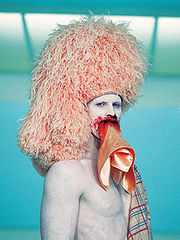
The Cremaster Cycle
Encyclopedia
The Cremaster Cycle is an art project consisting of five feature length films, together with related sculptures, photographs, drawings, and artist's books; it is the best-known work of American visual artist and filmmaker Matthew Barney
.
The Cremaster Cycle was made over a period of eight years (1994–2002) and culminated in a major museum exhibition organized by Nancy Spector of the Solomon R. Guggenheim Museum
in New York City, which traveled to the Museum Ludwig
in Cologne and the Musée d'art Moderne
in Paris from 2002-03. Barney's longtime collaborator Jonathan Bepler composed and arranged the soundtracks for the films.
, the primary function of which is to raise and lower the testes in response to temperature.
The project is filled with anatomical allusions to the position of the reproductive organs during the embryonic process of sexual differentiation: Cremaster 1 represents the most "ascended" or undifferentiated state, Cremaster 5 the most "descended" or differentiated.
The cycle repeatedly returns to those moments during early sexual development in which the outcome of the process is still unknown — in Barney's metaphoric universe, these moments represent a condition of pure potentiality. As the cycle evolved over eight years, Barney looked beyond biology
as a way to explore the creation of form, employing narrative models from other realms, such as biography
, mythology
, and geology
.
4 1994
1 1995
5 1997
2 1999
3 2002
actual production order of the movies,
compared with numerical order
The films were not made in numerical order (1–5), but rather in the order 4, 1, 5, 2, 3 – precisely, 4 in 1994, 1 in 1995, 5 in 1997, 2 in 1999, 3 in 2002. The numerical order is the thematic order, while in order of production the films increase in production quality and ambition, and they can alternatively be viewed in any order, as different views of a set of themes and preoccupations.
The films are significantly different in length; the longest (and last-made) is #3, at over 3 hours, while the remaining four are approximately 1 hour each, for a total of approximately 7 hours – #3 itself is almost half the total length. There is precious little dialog in any of the films; only #2 features significant dialog.
An important precursor of the Cremaster Cycle is Drawing Restraint, which is also a biologically inspired multi-episode work in multiple media, also featuring the field emblem.
versions, as on peer-to-peer networks.
Palm Pictures
, the distributor, has not made the series available on DVD, though there were some rumors and announcements to this effect in 2003. So far, only an excerpt, "The Order" (from episode 3) has been released on mass-market DVD.
The full series was released in a limited series of 20 sets of DVDs, sold each for at least $100,000, in custom packaging – as fine art, rather than mass-market movies. In 2007 one disc (Cremaster 2) sold for $571,000.


and The Waste Land
, while others dismiss it as vapid, self-indulgent tedium. This is summarized by one critic as "Barney's cinematic art inspires both awe and revulsion, often simultaneously." Indeed, the Village Voice featured two reviews, with art critic
Jerry Saltz
praising the cycle, and film critic J. Hoberman
panning it.
Lavish praise includes:"The Cremaster Cycle by Matthew Barney is the first truly great piece of cinema to be made in a fine art context since Dali and Bunuel filmed Un Chien Andalou in 1929. It is one of the most imaginative and brilliant achievements in the history of avant-garde cinema."
while scathing criticism describes it as "a mostly tedious succession of striking but vacant imagery whose effect diminishes the longer you look at it," from which "any sense of mystery or wonder is drained."
The visuals are roundly praised, however, and some (Hoberman) feel that the movies work well as parts of installations, due to visuals, though not as movies, due to poor editing and pacing.
Nancy Spector, Matthew Barney: The Cremaster Cycle, New York: Guggenheim Museum Publications, 2002.
Matthew Barney
Matthew Barney is an American artist who works in sculpture, photography, drawing and film. His early works were sculptural installations combined with performance and video...
.
The Cremaster Cycle was made over a period of eight years (1994–2002) and culminated in a major museum exhibition organized by Nancy Spector of the Solomon R. Guggenheim Museum
Solomon R. Guggenheim Museum
The Solomon R. Guggenheim Museum is a well-known museum located on the Upper East Side of Manhattan in New York City, United States. It is the permanent home to a renowned collection of Impressionist, Post-Impressionist, early Modern, and contemporary art and also features special exhibitions...
in New York City, which traveled to the Museum Ludwig
Museum Ludwig
Museum Ludwig, located in Cologne, Germany, houses a collection of modern art. It includes works from PopArt, Abstract and Surrealism, and has one of the largest Picasso collections in Europe. It also features many works by Andy Warhol and Roy Lichtenstein....
in Cologne and the Musée d'art Moderne
Musée d'Art Moderne de la Ville de Paris
Musée d'Art Moderne de la Ville de Paris is the City of Paris Museum of Modern Art dedicated to the arts of the 20th/21st centuries. It is located at 11 Avenue du Président Wilson in the 16th arrondissement of Paris.-Description:...
in Paris from 2002-03. Barney's longtime collaborator Jonathan Bepler composed and arranged the soundtracks for the films.
Overview
Nancy Spector has described the Cremaster cycle (1994–2002) as "a self-enclosed aesthetic system." The cycle includes the films as well as photographs, drawings, sculptures, and installations the artist produced in conjunction with each episode. Its conceptual departure point is the male cremaster muscleCremaster muscle
-Contraction:Its function is to raise and lower the testes in order to regulate the temperature of the testes and promote spermatogenesis. Contraction may also occur during arousal which can prevent injury to the testicles during sex....
, the primary function of which is to raise and lower the testes in response to temperature.
The project is filled with anatomical allusions to the position of the reproductive organs during the embryonic process of sexual differentiation: Cremaster 1 represents the most "ascended" or undifferentiated state, Cremaster 5 the most "descended" or differentiated.
The cycle repeatedly returns to those moments during early sexual development in which the outcome of the process is still unknown — in Barney's metaphoric universe, these moments represent a condition of pure potentiality. As the cycle evolved over eight years, Barney looked beyond biology
Biology
Biology is a natural science concerned with the study of life and living organisms, including their structure, function, growth, origin, evolution, distribution, and taxonomy. Biology is a vast subject containing many subdivisions, topics, and disciplines...
as a way to explore the creation of form, employing narrative models from other realms, such as biography
Biography
A biography is a detailed description or account of someone's life. More than a list of basic facts , biography also portrays the subject's experience of those events...
, mythology
Mythology
The term mythology can refer either to the study of myths, or to a body or collection of myths. As examples, comparative mythology is the study of connections between myths from different cultures, whereas Greek mythology is the body of myths from ancient Greece...
, and geology
Geology
Geology is the science comprising the study of solid Earth, the rocks of which it is composed, and the processes by which it evolves. Geology gives insight into the history of the Earth, as it provides the primary evidence for plate tectonics, the evolutionary history of life, and past climates...
.
4 1994
1 1995
5 1997
2 1999
3 2002
actual production order of the movies,
compared with numerical order
The films were not made in numerical order (1–5), but rather in the order 4, 1, 5, 2, 3 – precisely, 4 in 1994, 1 in 1995, 5 in 1997, 2 in 1999, 3 in 2002. The numerical order is the thematic order, while in order of production the films increase in production quality and ambition, and they can alternatively be viewed in any order, as different views of a set of themes and preoccupations.
The films are significantly different in length; the longest (and last-made) is #3, at over 3 hours, while the remaining four are approximately 1 hour each, for a total of approximately 7 hours – #3 itself is almost half the total length. There is precious little dialog in any of the films; only #2 features significant dialog.
An important precursor of the Cremaster Cycle is Drawing Restraint, which is also a biologically inspired multi-episode work in multiple media, also featuring the field emblem.
Availability
, the films are not available on mass-market DVDs, and according to the press release for the 2010 US tour, the cycle "is Not Now Nor Will it Ever be Available on DVD". The films are primarily available via periodic screenings, and in bootlegBootleg recording
A bootleg recording is an audio or video recording of a performance that was not officially released by the artist or under other legal authority. The process of making and distributing such recordings is known as bootlegging...
versions, as on peer-to-peer networks.
Palm Pictures
Palm Pictures
Palm Pictures is a US-based entertainment company owned and run by Chris Blackwell. Palm Pictures produces, acquires and distributes innovative music and film projects with a particular focus on the DVD format...
, the distributor, has not made the series available on DVD, though there were some rumors and announcements to this effect in 2003. So far, only an excerpt, "The Order" (from episode 3) has been released on mass-market DVD.
The full series was released in a limited series of 20 sets of DVDs, sold each for at least $100,000, in custom packaging – as fine art, rather than mass-market movies. In 2007 one disc (Cremaster 2) sold for $571,000.


Reception
Reaction to the cycle is sharply divided – some consider it a major work of art, on a par with Un Chien AndalouUn chien andalou
Un Chien Andalou is a 1929 silent surrealist short film by the Spanish director Luis Buñuel and artist Salvador Dalí. It was Buñuel's first film and was initially released in 1929 to a limited showing in Paris, but became popular and ran for eight months....
and The Waste Land
The Waste Land
The Waste Land[A] is a 434-line[B] modernist poem by T. S. Eliot published in 1922. It has been called "one of the most important poems of the 20th century." Despite the poem's obscurity—its shifts between satire and prophecy, its abrupt and unannounced changes of speaker, location and time, its...
, while others dismiss it as vapid, self-indulgent tedium. This is summarized by one critic as "Barney's cinematic art inspires both awe and revulsion, often simultaneously." Indeed, the Village Voice featured two reviews, with art critic
Art critic
An art critic is a person who specializes in evaluating art. Their written critiques, or reviews, are published in newspapers, magazines, books and on web sites...
Jerry Saltz
Jerry Saltz
Jerry Saltz is an American art critic. Since 2006, he has been senior art critic and a columnist for New York magazine. Formerly the senior art critic for The Village Voice, Saltz has been nominated for the Pulitzer Prize in Criticism three times. He was the sole advisor for the 1995 Whitney...
praising the cycle, and film critic J. Hoberman
J. Hoberman
James Lewis Hoberman , also known as J. Hoberman, is an American film critic. He is currently the senior film critic for The Village Voice, a post he has held since 1988.-Education:...
panning it.
Lavish praise includes:"The Cremaster Cycle by Matthew Barney is the first truly great piece of cinema to be made in a fine art context since Dali and Bunuel filmed Un Chien Andalou in 1929. It is one of the most imaginative and brilliant achievements in the history of avant-garde cinema."
while scathing criticism describes it as "a mostly tedious succession of striking but vacant imagery whose effect diminishes the longer you look at it," from which "any sense of mystery or wonder is drained."
The visuals are roundly praised, however, and some (Hoberman) feel that the movies work well as parts of installations, due to visuals, though not as movies, due to poor editing and pacing.
Further reading
The large volume by Nancy Spector, Matthew Barney: The Cremaster Cycle, is the standard work on the Cycle and contains reproductions of production stills, concept drawings and an exegetical essay by Spector, Only The Perverse Fantasy Can Still Save Us. Neville Wakefield has produced The Cremaster Glossary, which is also included in the book.Nancy Spector, Matthew Barney: The Cremaster Cycle, New York: Guggenheim Museum Publications, 2002.
Reviews
- Metacritic: Cremaster 3
- Metacritic: Cremaster Cycle
- The Cremaster Cycle, Peter Bradshaw, The Guardian, 17 October 2003
- Man vs. 'Cremaster': The 10-Hour Test, by John Rockwell, March 23, 2003
- Cults of Personality, J. HobermanJ. HobermanJames Lewis Hoberman , also known as J. Hoberman, is an American film critic. He is currently the senior film critic for The Village Voice, a post he has held since 1988.-Education:...
, Mar 11 2003, Village Voice - Swept Away: On Still Being Smitten With Matthew Barney, by Jerry Saltz, Feb 25 2003, Village Voice
- The Cremaster Cycle at IFC: Matthew Barney exposes his films again, Nathan Lee, May 18, 2010, Village Voice
- Cremaster works, OFFOFFOFF film review, David N. Butterworth
- Time Out Film Guide
- The Cremaster Cycle (2002), Movie Gazette – brief synopsis and review

